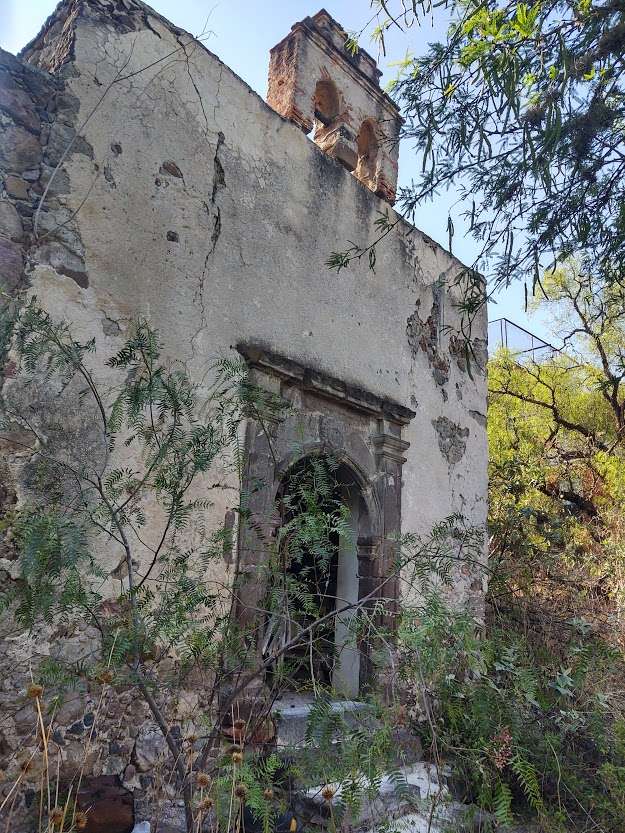There is the old adage that the best place to hide is often in plain sight. This certainly holds true for one of the most ancient chapels in the middle of San Miguel de Allende.
La Palmita is one of our four oldest neighborhoods and was originally set aside and marked by crosses for the indigenous to settle in (the Spanish settled down the hill in centro). Back during the Colonial era of San Miguel de Allende La Palmita was dotted with chapels on the hillside.
Today some of those chapels have been re-purposed in storage sheds, pool houses and alike still featuring their interior frescoes painted by long ago residents. Others can’t even be seen without a drone, hidden behind buildings and walls.

Still, I was surprised to find a new (to me) chapel on one of our most used and picturesque streets in town, Cruz de Pueblo. Cruz de Pueblo is a pedestrian only street with staircases that zigzag back and forth like Lombard St. in San Francisco.

The top area has been remodeled during the pandemic to feature sitting areas and a stage in the shadow of the cross atop the mountain once marking a boundary of La Palmita.
The ancient Toltecs believed each mountain had its own deity so they were inclined to build pyramids on local mountain tops. Much later the Spaniards arrived taking that tradition and using a mountain tops’ spirituality to be marked by a cross instead.
Before the condos loomed over the cross, it was my favorite spot to have a romantic picnic while the sun set over town, the lake and the mountains around Guanajuato.


About half way up the stairs, behind a green house, I noticed the rooftop of a 1700s chapel recently. Going to explore, I found the chapel was in remarkably good shape except for some broken windows in the ceiling.

The chapel door was ajar though largely blocked by piles of lumber stored there. You can peek around the door to see what could be indigenous frescoes in the distance. However, someone in the late 1960s or early 1970s, got really stoned and painted Jesus and some angels whose hair styles would seamlessly fit in on the Partridge Family bus.


Nearby is the largest calvario I’ve seen in the area. Calvarios are outside shrines the indigenous would place flowers and candles in to worship their ancestors before going in the adjacent chapel to celebrate the new faith. The calvario here features murals with waterfalls and indigenous dancing. They don’t look old enough to be original but they are very nicely done.
The chapel, like many in La Palmita, is completely land locked and hasn’t been active in some time. The Church, like with a condo, owns the interior while the government owns the outside. If masses are no longer held in a chapel the Church has no interest in the building and will, in effect, decommission it removing blessings formerly placed on the site. The government won’t maintain a chapel the Church isn’t using.

Speaking with neighbors whose homes back to the chapel, they say the land is for sale but not according to my real estate pal, Greg Gunter. Some had never visited the chapel and none knew the name or history.
Trying to research the name and history was a struggle as few even know of the chapel. Walking up or down the steps one eyes the steps, not around buildings. Even my pals that grew up there, or the local church offices, could not offer any insight.

Given the chapel is beside the path leading up to a sacred cross, the name of the chapel was likely The Sacred Cross and part of a then hacienda used for orchards or grazing. The Sacred Cross is one of the top three most common chapel names in the area. The other common names are The Virgin of Solitude (patroness of weavers that worked in the area) and Saint Isadore (patron of farmers that also worked there).

There are ruins of two chapels nearby named for The Three Kings (patrons of bringing children holiday gifts). One has been partially restored and is featured in the middle of the residential complex named for it, the Stone Chapel or Capilla de Piedra. Buildings in that development now surround the sacred cross.
If you happen to know more of the history of this lovely chapel smack in the middle of town, please contact me. Often with these old chapels their history disappears over the centuries of disuse as they turn into picturesque ruins.
by Joseph Toone
- TripAdvisor’s top tour guide with History and Culture Walking Tours and Joseph Toone Tours.
- Amazon’s best selling author of the San Miguel de Allende Secrets books.
- Author of the Maria Dolls coloring book helping indigenous doll makers.
- Creator of San Miguel de Allende Secrets YouTube channel with over 100 videos and 1,500 views monthly.

